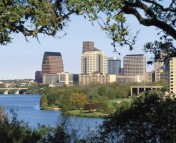This year, Astrobites will be liveblogging AAS. In order to avoid inundating our readers’ RSS feeds, we’ll be updating this post with short paragraphs about the talks we’ve heard and posters we’ve seen. So keep checking back throughout Wednesday morning! If you missed them, here are the Monday morning sessions, the Monday afternoon sessions, the Tuesday morning sessions, and the Tuesday afternoon sessions.
11:40 am – Invited Session: Magnetic Fields in the Formation of Stars and Protoplanetary Disks – Susana Lizano
We know that stars form in the dense cores of molecular clouds, but the efficiency of star formation in these cosmic cradles is very low, and the processes that occur in the dense cores are still very much a subject of debate. In this invited talk, Susana Lizano discussed the role of magnetic fields in the star formation process, by examining the mass-to-magnetic flux ratio in molecular clouds. Well-ordered magnetic fields are seen in many clouds, leading to the conclusion that magnetic support is probably important in these regions.
If there is a strong magnetic field in a dense core (a reasonable assumption, given that stars have strong B-fields), the magnetic braking could be strong enough to halt gravitational collapse, meaning that magnetic field dissipation must occur during collapse for a star to form. This dissipation could proceed via anomalous Ohmic resistivity, and an accretion disk can grow when the stellar envelope is depleted, which makes magnetic braking inefficient.
In addition to slowing gravitational collapse, magnetic fields modify the structure and dynamics of stellar accretion disks. Interestingly, this is relevant to planet migration theory, because magnetic field coupling slows the rotation of gas and dust in the disk to sub-Keplerian speeds, which causes a drag on planets in Keplerian orbits. This drag can dissipate the kinetic energy of the planet, resulting in inward migration. As a last result, Dr. Lizano pointed out that magnetic fields will increase the gravitational stability of disks, which is a problem for theories of planet formation that rely on gravitational instability leading to collapse.
11:30 am – Press Conference: Supernovae Near & Far, Far Away
Supernovae at z > 1.5 from the Hubble Space Telescope — Steven A. Rodney (Johns Hopkins Univ.)
The White Dwarf Progenitor of SN 2011fe — Joshua Bloom (Univ. of California, Berkeley)
Local Type Ia Progenitors: One Double Degenerate, No Symbiotics — Ashley Pagnotta (Louisiana State Univ.)
Commentary: Supernovae & Their Progenitors — J. Craig Wheeler (Univ. of Texas, Austin)
This was a very interesting press release largely addressing various aspects of the problem of Type 1a supernova progenitors. Type 1a supernovae are thought to be generated by one of two channels: 1) two white dwarfs orbiting each other inspiral; when they merge, if their combined mass is greater than the Chandrasekhar limit of 1.4 solar masses, a supernova occurs, or 2) a white dwarf (this primary) exists in a binary system with a donor star (the secondary); when the mass gain due to siphoning from the secondary causes the primary’s mass to exceed the Chandrasekhar limit, a supernova occurs.
Ashley Pagnotta presented results from a study of a recently-released Hubble image of supernova remnant 0509-67.5, a supernova that exploded 400 years ago, that attempts to determine which of these two channels generated the supernova. By examining the image at the center of the remnant, they looked for a star that might be the donor star, left over after the primary exploded in a supernova. They searched an expanded circle around the center that accounted for any feasible distance the star might have traveled in the 400 years since the explosion due to getting a velocity kick from the supernova, but found no point sources that could be the progenitor star. Thus they conclude that the supernova MUST have been generated by the first channel, with two white dwarfs merging.
J. Craig Wheeler followed up with a rebuttal, stating the spectral evolution models of Type 1a supernovae still support the second channel of supernovae formation.
Steven Rodney presented on the furthest yet detected Type 1a supernova, which exploded at a time when the universe was only about 4 billion years old. This discovery, made with Hubble’s WFC3, pushes into a new regime of supernovae — and one of the implications is that finding supernovae that exploded at such a young Universe age can place constraints on the progenitors.
Joshua Bloom discussed SN 2011fe, the supernova discovered earlier this year in the Pinwheel galaxy. Observations coincidentally made with a telescope in Spain just four hours after the supernova went off (and seven hours before the official discovery was made) place constraints on the size of the primary, demonstrating that it was a white dwarf. Their investigation of the secondary has thus far suggested a size of less than 10% of the Sun, indicating a compact progenitor is also likely.
Upshot: there has been verification that one observed supernova was formed by a double-white-dwarf merger, but this doesn’t prove that ALL Type 1a supernovae were generated in this way. There seems to still be plenty of room for debate on the matter.
10:30 am – Session 313: Asteroseismology by Kepler – Travis Metcalfe
Stars like our Sun display oscillations; the study of these oscillations is called asteroseismology. These oscillations are driven by convection near the surface, which sets up standing waves throughout the star. The photometric signature of these oscillations is small, but Kepler can see it. Asteroseismologists analyze this data by looking at the frequencies of the oscillations: frequency separations tell you about the physical properties of the star, such as the composition of its interior and the stellar density. Simple scaling relations can give you the stellar radius and mass if you know the effective temperature.
10:00 am – Session 313: Hiding in Plain Sight – Adric Riedel
Adric Riedel opened his thesis talk with a 3D diagram of stars in the solar neighborhood, pointing out that there are only 2000 where we expect 6000: there are a lot of faint, nearby stars that are yet to be discovered! He and the RECONS team are trying to find these stars. Adric’s thesis was on trying to find nearby low proper motion stars (proper motion is the apparent motion of a star across the sky). Recent (and less than recent) surveys have tried looking for the nearby high proper motion stars, but 18% of stars are thought to fall in the previously unstudied low proper motion regime.
Why bother to find these stars? First, there’s the general curiosity about what’s our there. Second, there’s the fact that these are the closest stars to us and are thus more readily studied. Adric found 25 new nearby M dwarfs that had previously been missing. He also found some nearby young, pre-main sequence stars and identified many as members of young stellar associations.
9:30 am – Press Release: The Nearest and Dearest Spiral Galaxies
Bright UV Stars in the Bulge of M31 – Philip Rosenfield, Univ. of Washington
In general, UV-bright stars tend to be young, and are generally found in the spiral arms of galaxies. The Panchromatic Hubble Andromeda Treasury (PHAT) project will map about 1/3rd of the closest large spiral galaxy, Andromeda, using 828 Hubble Space Telescope orbits. In the bulge of Andromeda, Rosenfield and the PHAT team find a number of these bright blue stars, which they have identified as 1 – 2 solar-mass stars that have been contaminated with metals, which become extreme horizontal branch (HB) stars, and failed asymptotic giant branch (AGB) stars, which are far brighter in the UV than their typical-metallicity HB and AGB cousins.
A Cluster of Blue Stars around M31’s Nuclear Black Hole – Tod R. Lauer, NOAO
M31 has a double nucleus of old star clusters surrounding a 10^8 solar-mass black hole. Interior to the old stellar clusters is a cluster of young blue stars, formed about 150 million years ago. Similar UV-bright stars are observed in the bulge of our own galaxy. This raises the question: why are these bright stars found preferentially near the supermassive black holes in galactic bulges? With more data from Hubble (and future telescopes), Lauer and others hope to find an answer.
What Color is the Milky Way? – Jeffrey A. Newman, Univ. of Pittsburgh
Color is one of the simplest properties to measure for many astronomical objects. In general, galaxy colors are a result of their star formation histories. Because so much of what we know about galaxies comes from their color, we would like to know the color of our own galaxy, but of course, taking a picture of a galaxy that we are living in is impossible. Thus, Newman and collaborators look at SDSS galaxies that are similar to the Milky Way, and try to infer properties of our galaxy from its analogs. They find that formation of new stars in the Milky Way is winding down, as we move from being a bright blue galaxy toward the red sequence. So what color IS the Milky Way? White, like “new spring snow seen in early morning light.”
8:30am – Dannie Heineman Prize: Robert Kirshner – Exploding Stars and the Accelerating Universe
Supernovae (SN) are excellent distance tracers because they are almost one million times brighter than the Cepheid Variables Hubble used to make his initial observations of an expanding universe and can be seen at great distances, but they are also rare. Type Ia SN are currently thought to occur when a star donates material to a companion white dwarf which then becomes unstable and undergoes a thermonuclear explosion releasing an incredible amount of radiation which we can see from across the universe. A recent supernovae in M101 termed SN2011fe has cast doubt on this model because while there is good evidence it was created by a small compact object like a white dwarf, there is no evidence for a larger companion like a star.
Nevertheless, these standard candles continue to inform us on things like the Hubble constant, neutrino count, and dark energy. All this work observing many supernovae to constrain the Hubble constant and acceleration of the universe could not have been done without the development of CCD’s which have increased our sensitivity to these distant events. It is important to remember that there exist issues that make this work tricky as well. Dust along our line of sight works to change the observed brightness of the supernovae and therefore affect our distance estimate, so this must be taken into account. These new large CCD cameras must also be able to observe thousands of galaxies at one time to increase the chances of observing enough supernovae in a reasonable amount of time.
Once the group Kirshner worked with had a reasonable sample of supernovae, a funny result was found. The universe must either have a negative amount of mass, or contain a cosmological constant! Now we have much tighter constraints on the value of this cosmological constant as well as the matter content of our universe. So know we know there is something out there causing our universe to accelerate, and the focus of the community has shifted to characterizing whatever that may be. Kirshner’s idea is to reduce the affects of dust and begin making measurements in the infrared. Some of this work has been done already, and it alone has decreased the scatter dramatically in the Hubble diagram. Congrats to Dr. Kirshner and his team for all their excellent work!





Trackbacks/Pingbacks